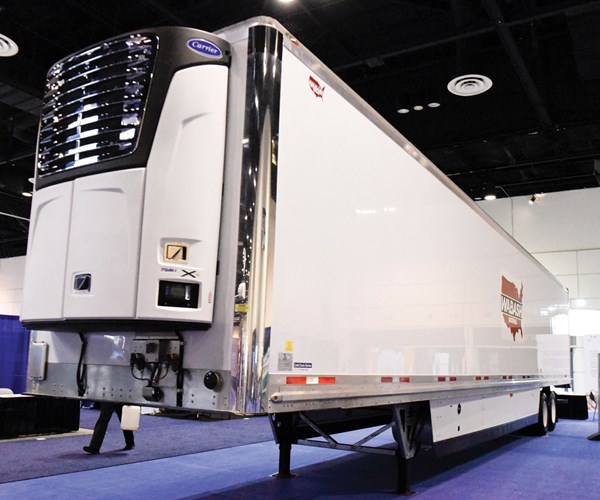CAMX 2017: Award winners, notable technologies
Awards for Composites Excellence and CAMX Awards winners from CAMX 2017, the SAMPE Lubin Award winner, and a smattering of other technologies from the show.
CAMX feature two awards programs, the Awards for Composites Excellence (ACE), sponsored by the ACMA, and the CAMX Awards. Below is a summary of the award winners, as well some other exhibits and technologies from the show.
CAMX Awards
The annual CAMX Awards recognize the cutting-edge innovations that are expected to significantly impact composites and advanced materials in the marketplace. This year’s winners were chosen for concepts and products that show strength through collaboration, while bridging low-cost materials/high-volume applications with high-performance applications/low-volume materials that are helping to shape the future of composites in the marketplace.

CAMX 2017 Wabash trailer.
The CAMX Unsurpassed Innovation Award winner was Structural Composites (W. Melbourne, Florida), recognized for its Next-Generation CoCure Hybrid Metal/ Composite Technology for Transportation, used in the fabrication of a refrigerated over-the-road semi-trailer for Wabash National Corp. (Lafayette, Indiana). The all-composite refrigerated van not
only includes composite walls and roof, but also a new hybrid metal/composite integrated floor that, when combined with the wall and roof systems, provides significant improvements in load rating, weight, thermal efficiency and longevity. The Wabash National 53-ft Cold Chain refrigerated van, which was on display on the exhibit hall floor, has a wear surface (ducted metal extrusions) bonded in-mold to the composite load structure using Structural Composites’ CoCure resin technologies. CoCure advanced coatings protect the wall and roof panels with a gelcoat-like nish, but also offer a tough, flexible coating that provides toughness and puncture resistance superior to that of conventional aluminum or composite construction. And, the floor has a certified fork lift rating of 24,000 lb, which is greater than the load limit of dry vans or any other refrigerated vans. The floors were fabricated with a patent-pending polyurethane/unsaturated polyester hybrid resin system supplied by BASF (Wyandotte, Michigan).
Scott Lewit, president of Structural Composites, received the award. He noted that the hybrid technology grew out of an SBIR grant, and then evolved into a commercial product. He was particularly thankful of Wabash National. “Wabash National took a big leap of faith and allowed us to innovate through failure,” Lewitt said. That partnership, he said, led to a new way of thinking to combine metals and composites in new ways.

CAMX 2017 Wicket gate.
The CAMX Combined Strength Award went to Composite Advantage LLC (Dayton, Ohio) for its GFRP Wicket Gates: Long-lasting Structures to Ensure Navigable Waterways. Many navigable waterways contain locks and dams to maintain water levels necessary to allow vessel passage; a wicket gate is a hinged component that can be raised with hydraulics to form a low dam to maintain pool level so that boats can pass. Typical wicket gates are made of solid white oak, an expensive and diminishing natural resource.
High costs and lack of resource availability drove the new wicket gate’s concept and design, and the composite gate is the first navigational structure made of composite materials to be used by the U.S. Army Corps of Engineers (USACE). The innovative GFRP composite wicket gate costs 40% less on a first-cost basis, provides an environmentally conscious alternative to old-growth hardwood, and increases a gate’s lifespan from 15 to 50 years, with virtually no maintenance.
Awards for Composites Excellence
The CAMX 2017 Awards for Composites Excellence (ACE) Awards are given for outstanding achievement in technology, manufacturing and product development. Here’s the rundown on this year’s winners.
2017 ACE award, Design Category, Most Creative Application was given to the Aerospace Corp. (El Segundo, California) for its submittal: Rapid Manufacture of Ultra- High Quality Composite Mirrors. While glass is conventionally used to manufacture optical components for space due to the ease of polishing and exceptional stability, the Aerospace Corp.’s product produces composite mirrors at a fraction of the weight of glass, using carbon fiber prepreg from TenCate Advanced Composites (Morgan Hill, California) as a substrate. Optical precision is attained via an optimized proprietary monolayer mold release coating, which eliminates post-polishing, and UV cure at low temperature for high-hygroscopic stability. Due to significant reduction in weight, cost and manufacturing time, these composite mirrors are expected to replace glass mirrors in space telescope missions that require large optics. This product is in the research and development stage with three pending U.S. patents and a contract negotiation to license for full-scale manufacturing.
2017 ACE Award, Design Category, Innovation in Green Composite Design was won by Oak Ridge National Laboratory (ORNL, Oak Ridge, Tennessee) for its Large-Scale 3D Printing Using 100% Bio-Composite Materials. Researchers, in collaboration with industrial partners, developed and demonstrated large-scale 3D printing using 100% bio-based and bio-degradable composites. These materials were used to 3D print a large portion of the world’s largest “green” printed pavilion structure, exhibited at the Design Miami Exposition, direct from digital design, with no waste. The complex architectural structure, of bamboo fiber-reinforced biopolymer developed at ORNL, had on-third the embodied energy and an order of magnitude lower carbon footprint compared to the carbon fiber/resin systems normally used in large-scale additive manufacturing. The material is also bio-degradable and designed for high-speed printing with a printing rate of up to 50 lb/hr.
2017 ACE Award, Manufacturing Category, Material and Process Innovation was taken by Gifu University (Gifu, Japan) for CFRTP Processing Technology using Commingling, Fiber Laying and “Light” Molding. This new process consists of three independent technologies: High-performance polyamide from Mitsubishi Gas Chemical is spun,
then commingled with a carbon ber yarn without losing textile working ability by Kajirene Inc.’s (Ishikawa, Japan) commingling technology. The commingled yarn is laid on a polyamide film by using Tajima fiber-laying embroidery machine. The commingled preform is then cured by a microwave irradiation molding system. The process promises to achieve lightweight, low-cost and recyclable composite parts, since tooling needs are minimal and material waste virtually non-existent.
2017 ACE Award, Manufacturing Category, Equipment and Tooling Innovation was presented to Autodesk (San Rafael, California) for its Comprehensive Composite Manufacturing Platform software. Autodesk’s software offering can improve manufacturing effciency by reducing design and manufacturing iterations using manufacturability and simulation. This analysis allows users to predict where fiber angle deviation, fiber wrinkle, fiber steering and compaction issues may occur.
2017 ACE Award, Market Growth Category, Infinite Possibility for Market Growth goes to Ashland LLC (Covington, Kentucky) for the Ford/Magna Carbon Fiber Subframe. Magna International Inc. (Aurora, Canada) in cooperation with Ford Motor Co. (Dearborn, Michigan), developed a prototype carbon fiber composite subframe that not only consolidates the number of parts needed in its assembly by more than 80%, but reduces part mass by 34%. The part is compression molded with Ashland’s epoxy vinyl ester resin and carbon fiber SMC technology (using Zoltek carbon fiber). Because the subframe is an integral part of the vehicle’s frame, it has greatly expanded the possibilities of composites use in a truly structural application for mass-produced vehicles. The subframe, which contributes to rigidity and crash management, has moved into vehicle-level testing at Ford and has the potential to shift the automotive market to consider composites in ways that have not been realized before.
Lubin Award

Lubin Award winner Dr. Charles Browning.
The Society for the Advancement of Material and Process Engineering (SAMPE, Diambond Bar, California) announced at CAMX that it has named Dr. Charles Browning as the recipient of the 2017 Lubin Award. The Lubin Award, named for George Lubin, an originator of reinforced plastics and a pioneer in the development and implementation of advanced composites for primary structures, had a long and distinguished career. This award, SAMPE’s highest honor, is given to recognize individuals who have made significant contributions to the field of material and process engineering.
Browning is an internationally recognized expert in his profession and in the advancement of advanced composite material technology. He is a major contributor to the United States national defense and its aerospace industry. Through his management, he shaped investment strategy over a 22-year period from 1983 to 2005 that enabled the Air Force to realize the benefits of advanced composites on the F-16, B-1, B-2, F-22 and F-35. His investments in composite processing, thermoplastics, high-temperature polyimides, and the Composites Affordability Initiative have provided the Air Force significant war-fighting capability.
In addition, through the confidence the aerospace industry gained on the use of composites for Air Force aircraft, they were able to apply composites to civil aircraft, from the general aviation community through commercial airliners like the Boeing 787 and Airbus A350 XWB.
Auto and aero

CAMX 2017 Audi A8 side panel in 3A/Baltek booth.
3A Composites/Baltek Inc. (High Point, North Carolina) featured the carbon fiber side panel for the Audi R8 GT sports car. The panel, manufactured by SGL Carbon SE (Wiesbaden, Germany; formerly joint venture BENTELER-SGL) features core material supplied by 3A Composites/Baltek to help keep material costs down but still allow the part to meet strength requirements. The panel also features Soric TF (from Lantor, Veenendall, The Netherlands), a resin flow medium for infusion and prepreg processes that provides high-quality print blocking.

CAMX 2017 Fast Eddy concept car in Rampf booth.
Tooling material supplier RAMPF Group Inc. (Wixom, Michigan) featured the first-generation mid-engine Fast Eddy concept car, being developed and manufactured by specialty carmaker Aria Group (Irvine, California). RAMPF provides tooling materials for some of the vehicle’s composite parts, including RAKU Tool Close Contour Paste 6070/6072 and RAKU Tool SB-0096 polyurethane tooling board. The car, which is designed to harken back to older Corvette designs, features a 650-hp small-block V8 engine. Aria says it will make about 20 Fast Eddy cars, starting in 2018. Price reportedly will be about $500,000.

Carbon fiber rotor blade for the Bell 206 JetRanger, manufactured by Van Horn Aviation in Tempe, Arizona.
Carbon fiber and prepreg manufacturer Toray (Tacoma, Washington) featured at its booth a section of a carbon fiber helicopter rotor blade manufactured by Van Horn Aviation (Tempe, Arizona) for the Bell 206 JetRanger. The main rotor and tail rotor were converted from an all-metal design and feature Toray’s 2510 out-of-autoclave carbon fiber prepreg.
Related Content
Plant tour: Middle River Aerostructure Systems, Baltimore, Md., U.S.
The historic Martin Aircraft factory is advancing digitized automation for more sustainable production of composite aerostructures.
Read MorePlant tour: Spirit AeroSystems, Belfast, Northern Ireland, U.K.
Purpose-built facility employs resin transfer infusion (RTI) and assembly technology to manufacture today’s composite A220 wings, and prepares for future new programs and production ramp-ups.
Read MoreNovel dry tape for liquid molded composites
MTorres seeks to enable next-gen aircraft and open new markets for composites with low-cost, high-permeability tapes and versatile, high-speed production lines.
Read MoreNext-generation airship design enabled by modern composites
LTA Research’s proof-of-concept Pathfinder 1 modernizes a fully rigid airship design with a largely carbon fiber composite frame. R&D has already begun on higher volume, more automated manufacturing for the future.
Read MoreRead Next
Modeling and characterization of crushable composite structures
How the predictive tool “CZone” is applied to simulate the axial crushing response of composites, providing valuable insights into their use for motorsport applications.
Read More“Structured air” TPS safeguards composite structures
Powered by an 85% air/15% pure polyimide aerogel, Blueshift’s novel material system protects structures during transient thermal events from -200°C to beyond 2400°C for rockets, battery boxes and more.
Read MoreCFRP planing head: 50% less mass, 1.5 times faster rotation
Novel, modular design minimizes weight for high-precision cutting tools with faster production speeds.
Read More






















